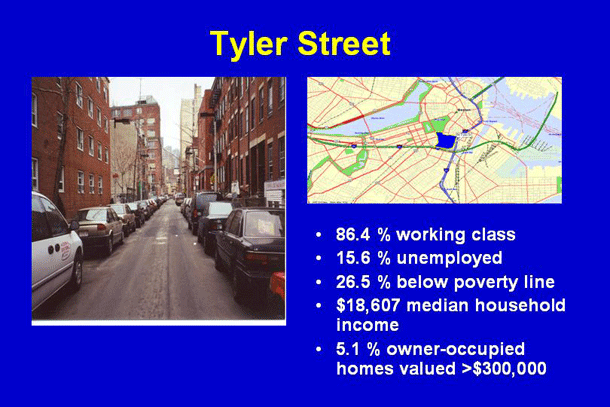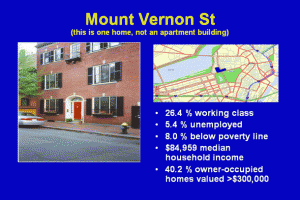Generating ABSMs: concepts, methods, and measures
Generating area-based measures of socioeconomic position requires an explicit approach to understanding what socioeconomic inequality is and how to measure it, at multiple levels. In this section we briefly review our definitions of “social class” and “socioeconomic position,” and then delineate our approach to generating and appraising the validity and utility of our Project’s area-based socioeconomic measures (ABSMs).
Definitions: social class and socioeconomic position
Starting first with definitions, in the Public Health Disparities Geocoding Project we used the construct of “social class” to refer to social groups arising from interdependent economic relationships among people . Stated simply, broad classes–like the working class, business owners, and their managerial class–exist in relationship to and co-define each other. One cannot, for example, be an employee if one does not have an employer and this distinction–between employee and employer–is not about whether one has more or less of a particular attribute, but concerns one’s relationship to work and to others through a society’s economic structure. Also at issue is an asymmetry of economic relations, whereby owners of resources (e.g., capital) gain economically from the labor or effort of employees.
Class, as such, is therefore logically and materially prior to its manifest expression in what can be referred to as socioeconomic position, an aggregate concept that includes both resource-based and prestige-based measures, as determined by both childhood and adult social class position . Resource-based measures refer to material and social resources and assets, including income, wealth, and educational credentials; terms used to describe inadequate resources include “poverty” and “deprivation.” Prestige-based measures refer to individuals’ rank or status in a social hierarchy. The term “socioeconomic status” should accordingly be avoided both because it arbitrarily (if not intentionally) privileges “status” over material resources as a determinant of health and because it conflates pathways involving material resources with those involving psychosocial appraisals of relative status.
Measuring socioeconomic position: domains, levels, & lifecourse
Key domains of socioeconomic position relevant to understanding population health thus include :
- Occupational class, which can affect health both directly and indirectly, via occupational hazards and via wages or income, relevant to standard of living;
- Educational attainment/credentials, usually reflective of childhood socioeconomic position and relevant to future economic prospects, and also relevant vis a vis knowledge & health literacy;
- Income & entitlements/subsidies, together affecting standard of living, noting that what “income” buys in a given society is related in part to what is provided by the social wage;
- Wealth, referring to accumulated assets, with important distinctions between what’s readily fungible or not (e.g., stocks vs equity in a home), plus also wealth’s converse, i.e., debt; and
- Relative social ranking, typically referring to “status” & “prestige.”
Second, each domain can be assessed at multiple levels, including: individual, household, and area or neighborhood, plus also regional, national and global .
Likewise, relevant moments during the lifecourse for which one may want socioeconomic data include: in utero, infancy, childhood, plus early, middle, and late adulthood .
From this vantage, we opted to create a variety of ABSMs, intended to capture diverse domains of SEP, for diverse outcomes that spanned the lifecourse, literally from birth until death.
Formulating the ABSMs from census data
As described more fully in our Project’s manuscripts , we created 19 theoretically-justified ABSMs (11 single variable, 8 composite ABSMS), delineated in the ABSM Creation Table. Two criteria central to formulating these ABSMS for socioeconomic position (SEP) were that they: (a) meaningfully summarized important aspects of the specified area’s socioeconomic conditions, and (b) employed socioeconomic data that could legitimately be compared over time and across regions
. Based on our a priori conceptual definitions of SEP and social class1 and US, UK, and other global evidence emphasizing detrimental effects of material deprivation on health
, we developed ABSMs for 6 domains of SEP: occupational class, income, poverty, wealth, education, and crowding, premised on the understanding that social class, as a social relationship, fundamentally drives the distribution of these manifest aspects of SEP
. Of note, one measure we included differs from the others: the Gini coefficient, which is a measure of within-area socioeconomic inequality rather than a measure of the average socioeconomic level of an area
. We included it because of concerns expressed about its uncritical use at the BG and CT level, given realities of economic segregation
.
Operationally, we generated each ABSM at each level of geography for each state. Among the composite variables, two were US analogues of the UK Townsend and Carstairs
deprivation indices, one used the algorithm for the US Center for Disease Control and Prevention’s “Index of Local Economic Resources,
” and five were created exclusively for our study. To mirror the skewed population distribution of socioeconomic resources, “SEP1” and “SEP2” simultaneously combined categorical data on poverty, working class, and either wealth or high income. Finally, we produced an “SEP index” akin to the Townsend index, based on summation of standardized z scores of selected ABSM.
Lastly, our a priori criteria for evaluating the ABSMs pertained to: (1) external validity (did it detect the expected socioeconomic gradients for each outcome, i.e., positive, negative, or none at all?), (2) robustness (did the ABSM do so across multiple outcomes, as well as within diverse population groups?), (3) completeness (was the ABSM relatively unaffected by missing data?), and (4) user-friendliness (was it easy to understand and use?) . Based on these criteria, and the key findings we summarize in the introduction to this monograph, in the case example developed for this monograph, we focus solely on the census tract poverty ABSM.
Example: Creating a single variable ABSM – % of persons below poverty
This section will describe how to create a single variable ABSM from census data, using the example of “percent of persons below poverty.” As indicated in the ABSM creation table (Area-based socioeconomic measures: constructs and operational definitions, using 1990 US census data), the data for creating this variable for 1990 is available from census table P117, available from the summary tape file 3 (STF3). P117 gives population counts of persons above and below poverty, stratified by age. As an example, p117 shows the counts for table P117 for all of Massachusetts.
To calculate the proportion of persons below poverty for this region, we sum all categories P1170001 to P1170024 to get the denominator, and sum categories P1170013 to P1170024 to get the numerator, and then simply divide this numerator by the denominator:
(P1170013 + … + P1170024) / (P1170001 + … + P1170024)
Creating a composite ABSM is similar in principle to creating a single variable ABSM, but requires a few extra steps. The Townsend ABSM consists of four components, percent crowding, percent unemployment, percent of individuals who do not own cars, and percent renters. The ABSM creation table (Area-based socioeconomic measures: constructs and operational definitions, using 1990 US census data) indicates where these four variables can be found as tables in the 1990 STF3 census data.
After obtaining the data from the census tables, the first step in creating the Townsend Index is to transform each area’s value for each component factor j into a standardized Z score. The Z score for area i is calculated as:
Z = (X
– m
) / s
Where X is the value of component variable j for area i where m
is the mean of component j across all areas and s
is the standard deviation of the component variable j over all areas.
The second step to create this index is to sum the Z score values from each of the four components of the index.






You must be logged in to post a comment.